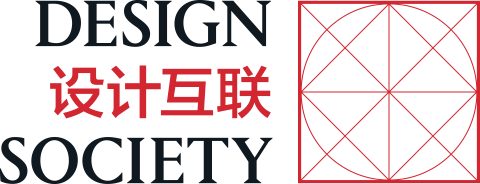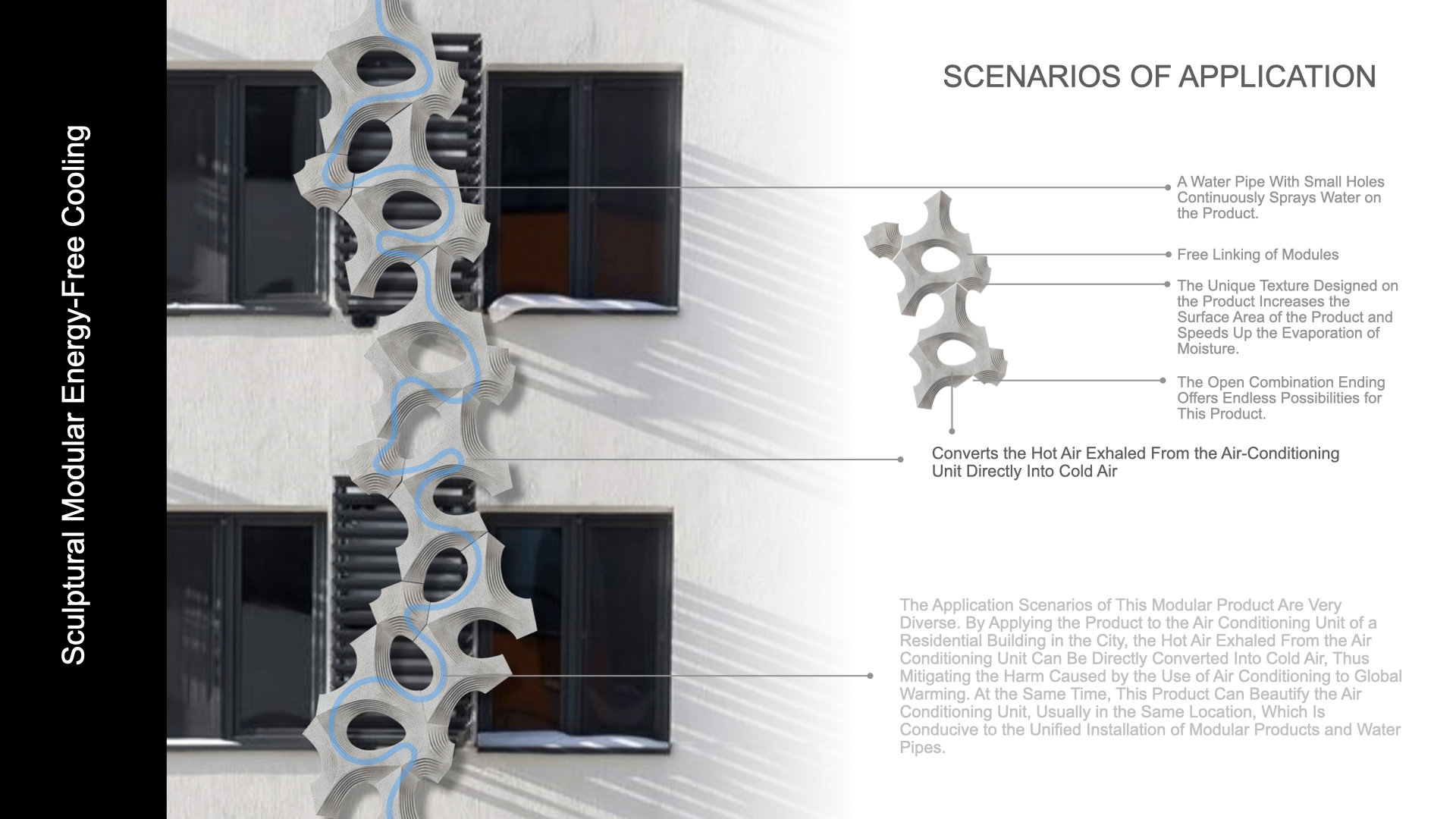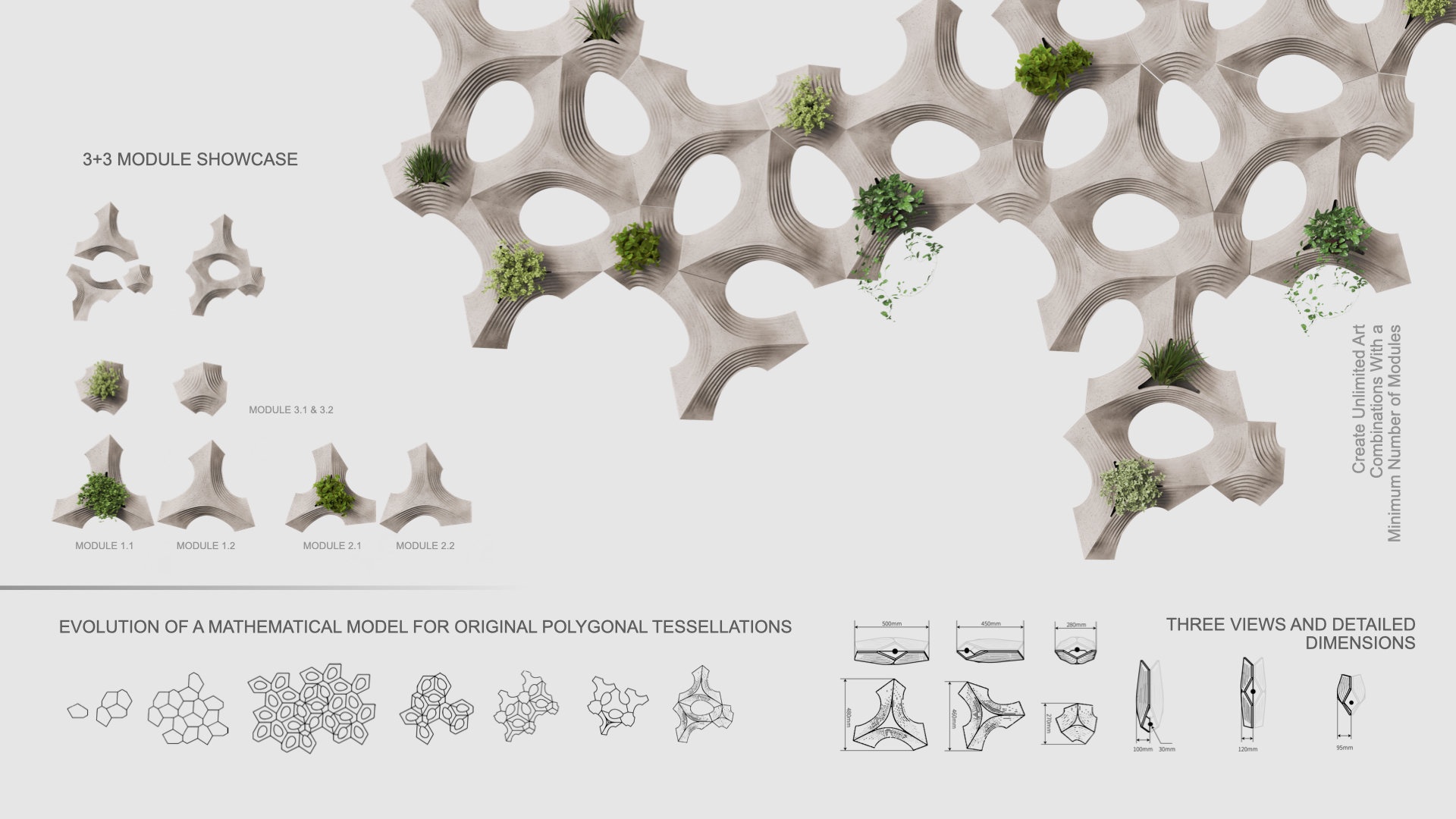
Energy-free cooling, introduction of each functional module and its size

No energy cooling module, internal structure connection mode
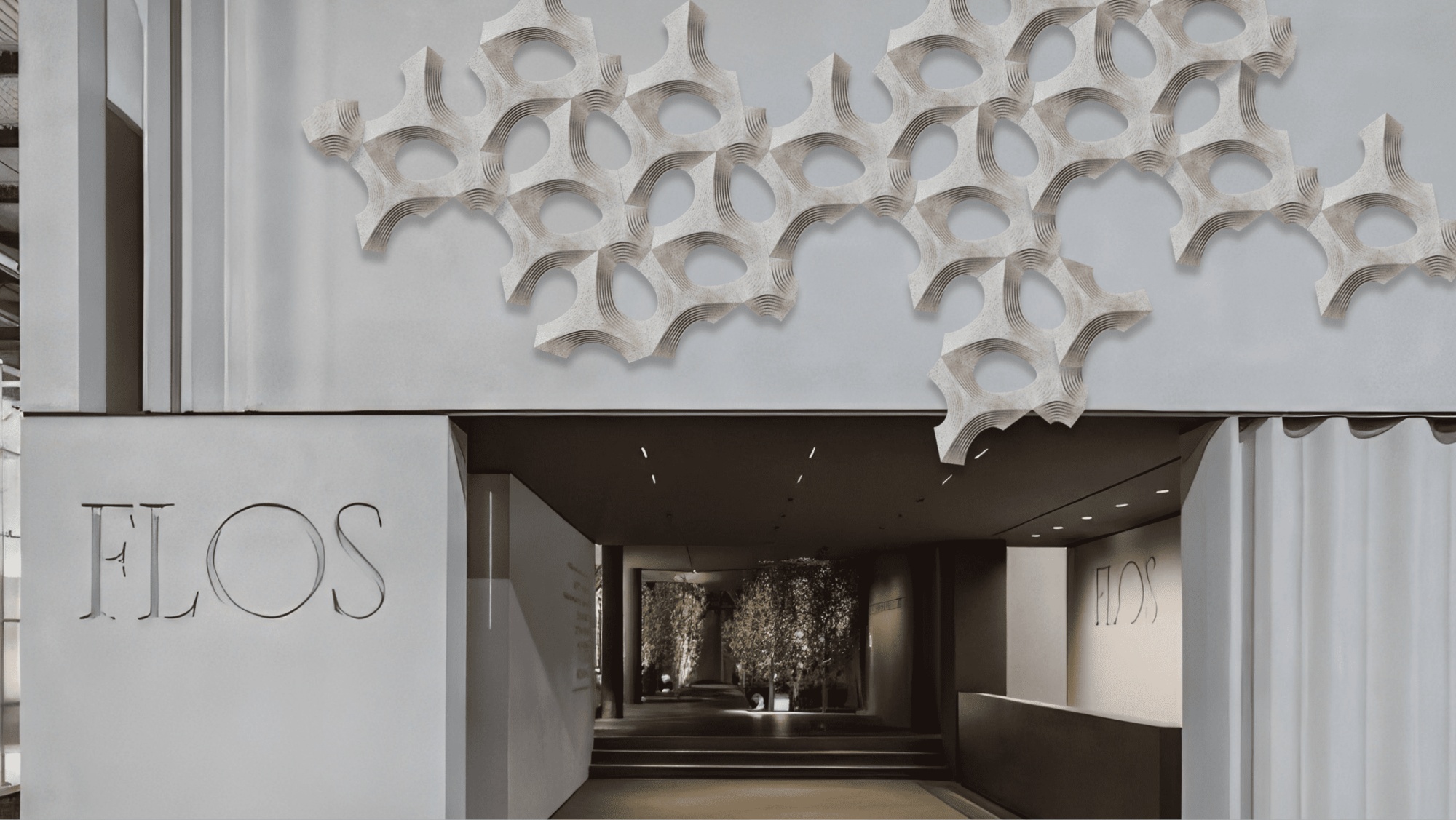
Application of Sculptural Energy-less Cooling Module on the Door Head Facade of Commercial Building
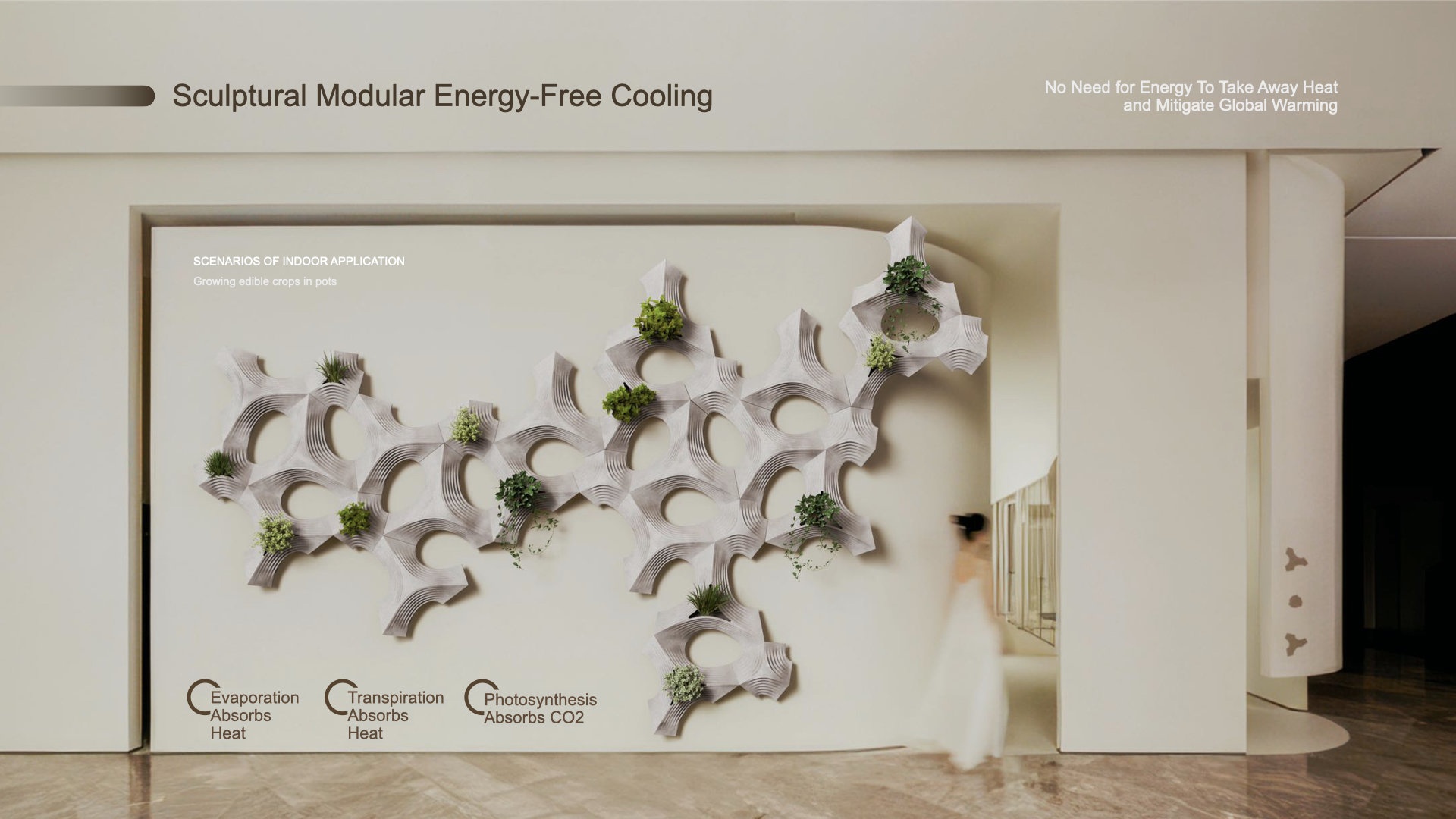
Application of Sculptural Inenergy Source Cooling Module in Commercial Facade

Application of Non-energy Cooling Module on Decorative Surface of Air Conditioner
By installing this energy-free cooling module, the hot air exhaled from the external air conditioner can be converted into cold air to alleviate the suffering of outdoor people from the hot air exhaled from the external air conditioner. At the same time, the hot air exhaled from the external air conditioner can evaporate moisture, provide a source of wind energy, accelerate moisture evaporation and take away heat. According to the current research, most buildings in China are designed at the same time, the external air conditioners are generally standardized in the same position, providing a natural environment for the application of these products..
Oasis curtain introduction video
The Oasis Curtain Wall project originated from the study of the Zeer Pot, a traditional African refrigerator that does not require energy, and its cooling principle is based on the transpiration of water to take away heat. We take this as inspiration, combined with the modern design language, the use of innovative materials and the research of future ecological habitat, designed an ecological decorative curtain wall with no energy cooling function and sculpture beauty. (This project is one of the research results)
In terms of morphological design, the oasis curtain wall adopts modular design language, applies the mathematical principle of polygonal continuous graphics, and designs six modules (divided into three categories: large, medium and small, each category includes two kinds of planting and non-planting), which can realize the pattern arrangement of infinite extension. This flexible modular system is easy to adapt to different scenes and volumes, such as shopping malls, building facades, restaurants, air conditioners, etc., to meet diverse space requirements.
In terms of material and function realization, the oasis curtain wall uses waste clay and ceramic materials to make porous ceramic modules. Its material is rich in tiny pores and has strong water absorption and air permeability. After wetting, it can naturally cool down through the transpiration effect, effectively reducing the ambient temperature, thereby reducing the dependence on air conditioning and achieving the effect of energy saving and emission reduction. A hollow hose system is integrated inside the module, which can continuously wet the curtain wall and keep the cooling effect for a long time. Part of the mold and planting groove, the internal laying of soft absorbent cotton, can absorb water for three-dimensional greening planting.
In terms of function and application scenario, the oasis curtain wall has a variety of application scenarios, through ecological aesthetics and cooling function to help create a healthy living environment. Outdoor scene: oasis curtain wall can be used as building facade or urban landscape decorative curtain wall, its sculptural form beautifies the city, at the same time, can plant green plants, help to absorb pollutants in the air and reduce the urban heat island effect. In addition, when it is installed outside the air conditioner, it can absorb the hot and humid gas discharged from the air conditioner, thereby reducing the influence of the air conditioner on the outside temperature and reducing the vicious circle of the thermal cycle. Interior scene: the oasis curtain wall can be used for three-dimensional planting in restaurants and other spaces, such as planting edible spice plants, which can not only cool down, but also add natural beauty to the dining environment and strengthen the interactive experience. At the same time, it can also be used as a family ecological planting device to meet the residents' self-sufficiency demand for organic vegetables, improve the healthy eating experience and reduce the carbon footprint.
In terms of sustainable impact, the oasis curtain wall provides an innovative optimization scheme for the design of sustainable urbanization and ecological human settlements in the future. Facing the complex problems of global warming, urban pollution, heat island effect and healthy living needs, it explores sustainable energy-free cooling methods through modern optimization of traditional wisdom. Its modular, multi-functional and sustainable characteristics, for the future of urban design depicts a aesthetic, but also in line with the ecological ethics of the future ideal of human settlements.
1. The integration of design concept and traditional Chinese wisdom
The design of the oasis curtain wall is inspired by the traditional cooling principle of the African Zeer Pot (Zeer Pot), which is similar to the traditional architectural wisdom of ancient China, such as "karez" and "pavilion. Karez guides water flow through underground channels and uses the evaporation of soil and water to achieve cooling, while the oasis curtain wall uses the transpiration effect of porous ceramic modules to achieve energy-free cooling. This design concept is not only a modern interpretation of African traditional wisdom, but also echoes the ancient Chinese ecological wisdom, reflecting the ingenious use of natural resources and the pursuit of sustainable development.
2. Modular design and the adaptability of China's urbanization
The oasis curtain wall uses a modular design language, a flexible system that can be adapted to the diverse needs of China's rapid urbanization. In China, with the acceleration of urbanization, urban space is becoming increasingly tense. The modular design of oasis curtain wall can be flexibly combined according to different scenes and volumes, such as shopping malls, building facades, restaurants and other places. This design not only improves the utilization rate of space, but also adds elements of ecological aesthetics to the urban landscape, which is in line with China's goal of building a "beautiful China" and "ecological civilization.
3. Material innovation and sustainable development practice in China
The oasis curtain wall uses waste clay and ceramic materials to make porous ceramic modules. This material selection not only reflects the reuse of waste resources, but also conforms to the "circular economy" and "resource-saving and environment-friendly" that China has vigorously promoted in recent years. The construction of a society is compatible. By using waste materials, the oasis curtain wall reduces resource consumption and environmental pollution, and provides innovative solutions for China's sustainable development.
4. Ecological function and improvement of urban environment in China
The ecological function of the oasis curtain wall is highly compatible with the needs of China's urban environment improvement. In China, many cities face the challenge of heat island effect and air pollution. Through its natural cooling function of transpiration effect, the oasis curtain wall can effectively reduce the ambient temperature, reduce the dependence on air conditioning, and reduce energy consumption and carbon emissions. In addition, the three-dimensional greening function of the oasis curtain wall helps to absorb pollutants in the air and improve urban air quality. These functions not only help alleviate the urban heat island effect, but also create a healthier and more livable living environment for residents.
5. Cultural connotation and the promotion of China's living environment
The design of oasis curtain wall is not only functional, but also contains rich cultural connotation. Its sculptural form and ecological aesthetic design can add artistic beauty to Chinese cities and buildings and enhance the quality of the living environment. In China, with the improvement of people's living standards, the requirements for quality of life and ecological environment are getting higher and higher. The three-dimensional greening function of the oasis curtain wall can provide natural beauty for restaurants, families and other spaces, enhance the interactive experience between man and nature, and conform to the traditional concept of Chinese people's pursuit of "harmony between man and nature.
Social Impact and Community Involvement
The application of oasis curtain wall can also promote community participation and social interaction. For example, the installation of oasis curtain wall in the community public space can provide a platform for residents to participate in the planting and maintenance of green plants, and enhance community cohesion. This design not only helps to improve the community environment, but also promotes communication and cooperation between residents through community activities, and enhances the vitality and happiness of the community.
Crystal is an independent designer committed to the deep integration of environmental protection and modern design. With extensive design experience and a strong academic background, she focuses on solving environmental problems and promoting sustainable development through innovative design. In her design philosophy, environmental protection is not only a responsibility, but also an expression of lifestyle. She firmly believes that the power of design can guide people to spontaneously participate in environmental protection actions, so as to achieve a harmonious coexistence between man and nature.
Crystal graduated from THU with two master's degrees, UoE and RCA. Throughout her career, she has explored new boundaries of design, incorporating cutting-edge concepts such as unconscious design, emotional design, sustainable design and green design into every project. She has cooperated with many international well-known enterprises and institutions, accumulated rich practical experience, and won many design awards.
Hou Jialu, an innovative designer, graduated from the Royal College of Art and was awarded the Special Recognition Award. Focus on interdisciplinary design, exploring the integration of smart products, emerging technologies and aesthetic fashion. His works have appeared in international exhibitions such as London Design Festival, China National Art Exhibition and Bangkok Design Week, and won many international awards such as Red Dot Concept Award, DNA Paris Design Award for Emerging Designer of the Year, Helen Hamlyn Design Award, etc.
